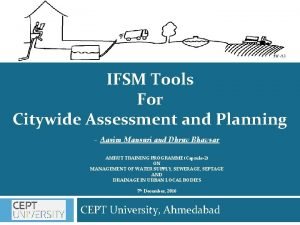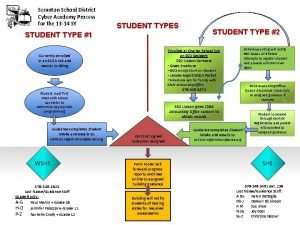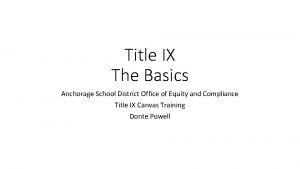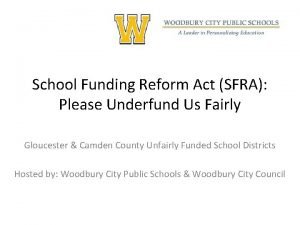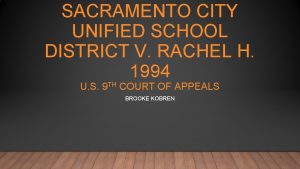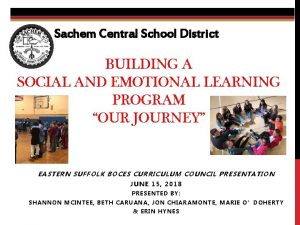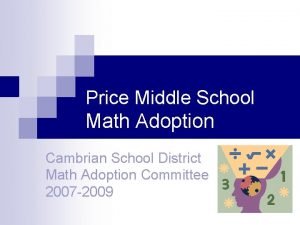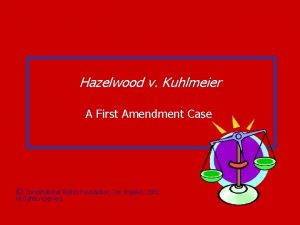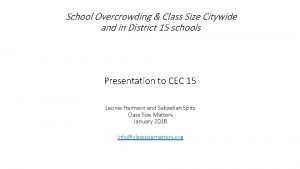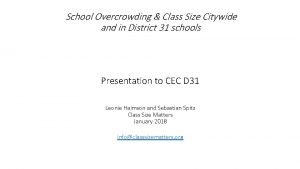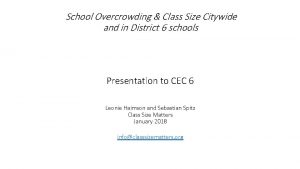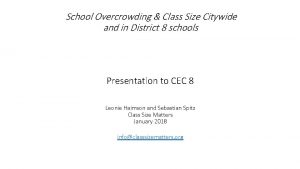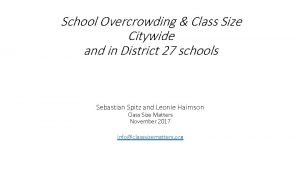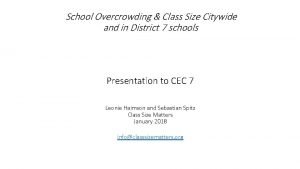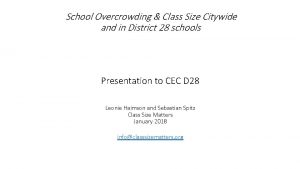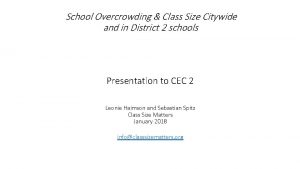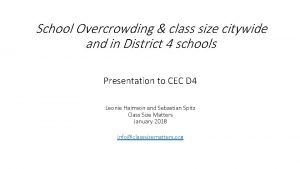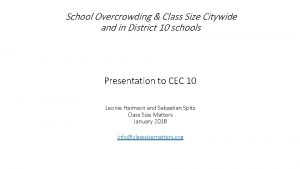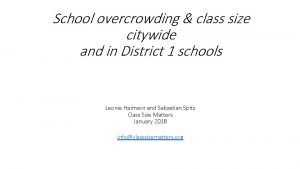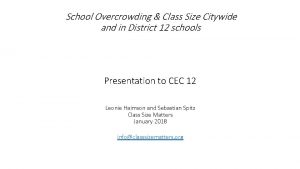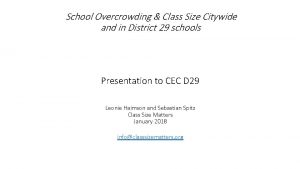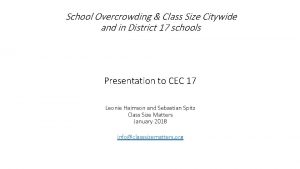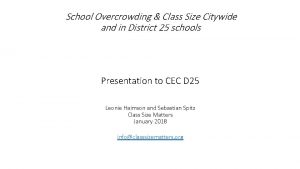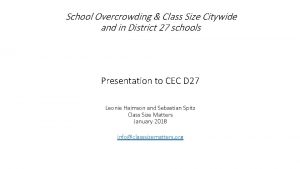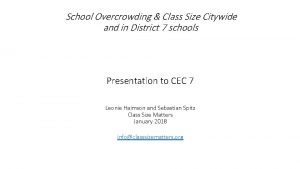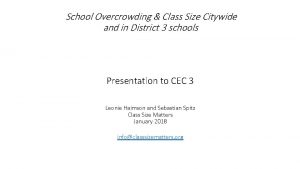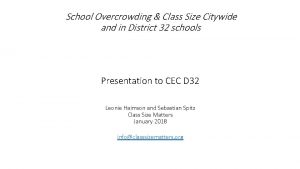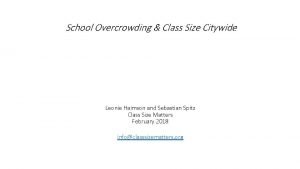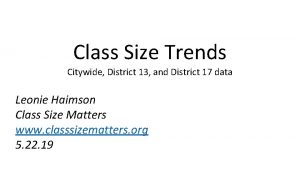School Overcrowding Class Size Citywide and in District



























- Slides: 27

School Overcrowding & Class Size Citywide and in District 19 schools Presentation to CEC 19 Leonie Haimson and Sebastian Spitz Class Size Matters January 2018 info@classsizematters. org

This fall, District 19, average K-3 class sizes decreased by. 3, now 1. 4 students below citywide average but 2. 7 students above Contracts for Excellence goals set in 2007. D 19 K-3 rd Class size trend 29 27 25 23 21 19. 8 20. 9 20. 7 19. 5 21. 4 20. 5 19. 9 22. 1 21. 0 20. 3 22. 9 21. 7 20. 1 23. 9 22. 8 19. 9 24. 5 23. 6 24. 9 24. 0 24. 7 23. 2 24. 6 23. 6 24. 2 22. 9 24. 0 22. 6 19. 9 17 Baseline 2007 -8 2008 -9 2009 -10 2010 -11 C 4 E goals 2011 -12 2012 -13 Citywide actual 2013 -14 D 19 2014 -15 2015 -16 2016 -17 2017 -18

Average class size grades 4 -8 increased by. 6, now 1. 0 students below Citywide average and 2. 7 students above C 4 E goals D 19 4 -8 th Class size trend Average Class Size 28 26 25. 1 24. 8 24 23 22. 2 22 25. 8 26. 3 25. 3 24. 6 23. 9 24. 8 22. 9 23. 8 23. 3 26. 6 26. 7 26. 8 26. 7 25. 3 25. 2 25. 1 25. 4 22. 9 26. 6 25. 0 22. 9 26. 6 25. 6 22. 9 20 Baseline 2007 -8 School Year 2008 -9 2009 -10 2010 -11 2011 -12 2012 -13 2013 -14 2014 -15 2015 -16 2016 -17 2017 -18 C 4 E target Citywide actual D 19

Citywide average HS class sizes stayed the same per class; and remain far above C 4 E goals Citywide HS class size average Compared to C 4 E goals Up 1. 5% since 2007 28 Average Class Size 27. 5 27 26. 5 26 26. 1 26. 2 26 25. 7 25. 5 26. 7 26. 4 26. 3 24. 5 26. 8 26. 7 26. 5 Citywide Actual C 4 E Target 25. 2 25 24. 8 24. 5 26. 5 24 2007 -08 2008 -09 2009 -10 2010 -11 2011 -12 2012 -13 2013 -14 School Year 2014 -15 2015 -16 2016 -17 2017 -18

DOE promised State Ed in 2014 to focus on reducing class size at Renewal schools • Yet 42% of Renewal schools did NOT reduce average class sizes from 2014 -2015 to 2017 -2018 • 73% continue to have maximum class sizes of 30 or more in November 2017. • NO renewal schools have capped class sizes at C 4 E levels • Source: Preliminary NYC Class Size Reports, November 2014 and November 2017

Four Renewal Schools in D 6, including High Schools • Cypress Hill Collegiate Preparatory School, Multicultural High School, PS 306 Ethan Allen, PS 328 Phyllis Wheatley • Three of the four schools have increased class sizes since the start of the Renewal program in 2014, and continue to have at least one class of 30 or more : Cypress Hills, Multicultural HS, and PS 328 • Cypress Hills Collegiate Preparatory School will be leaving the Renewal program at the end of the year to become a Rise School • Ps 306 Ethan Allen reduced class sizes from 23. 5 in Nov 2014 to 20. 7 in Nov 2017, and does not have any classes of 30 or more • Source: Preliminary NYC Class Size Reports, November 2014 and November 2017

Scope of school overcrowding enormous • 43% NYC schools were overcrowded last year according to DOE data • About 575, 000 students (56% of total) were enrolled in overcrowded schools • About 350, 000 (68% of total) elementary students enrolled in overcrowded schools • About 50, 000 (33% of total) middle school students enrolled in overcrowded schools • About 175, 000 (49% of total ) HS students enrolled in overcrowded schools Data source: Schools at or above 100% according to SCA “Blue Book” 2016 -2017

Why are our schools so overcrowded? • Bloomberg claimed to have created 100, 000 new seats between 2004 and 2013 • Yet only 45, 000 new NET seats created if seat loss taken into account • About 55, 000 seats were lost due to lapsed leases, elimination of TCUs (trailers), annexes, and mini- buildings • Also, enrollment grew fast especially at the elementary school level • The following charts are from our recent Seat Loss report, available online at www. classsizematters. org

Enrollment grew faster than new seats in NYC elementary schools

In District 19, elementary enrollment decreased by 410, while capacity increased by 1, 091

While 45, 000 net seats were gained citywide, nearly all were filled by the increased number of charter school students

November 2017 DOE five-year capital plan still very underfunded • Funds fewer than 45, 000 seats citywide – about half (54%) necessary to alleviate current overcrowding and accommodate enrollment growth, according to DOE estimates. • Only 37% of seats compared to DOE’s analysis of need have sites and are in process of scope and design. • There is a huge variation across districts in the number and percent of seats funded compared to DOE’s estimate of need. • Bronx is the most underfunded borough according to the percent of unmet need for seats; Queens in terms of total number of unfunded seats.

DOE Identified need for 83, 056 K-8 seats citywide 1, 000 seats in District 19 Nov. 2017 capital plan Districts not included below have NO need for new seats according to DOE 12000 10322 9403 10000 7546 Qu 30 28 27 26 400 25 24 3348 2504 1736 2436 1300 22 20 1000 19 15 1563 14 13 12 2492 1484 11 10 9 8 7 5 3 1028 692 2451028 572 0 3638 3417 4000 3232 2000 5123 21 6000 5975 District 6880 ee 31 ns HS SI HS 5692 2 Total Need 8000

54% K-8 seats funded citywide compared to DOE estimate of need 100% of need funded in District 19 Data: Nov. 2017 capital plan Percent of Seat Need funded in the Capital Plan 100. 0% 97. 5% 100. 0% 86. 3% 75. 9% 61. 5% 74. 6% 63. 4% 52. 0% 51. 8% 44. 4% 50. 0% 47. 2% 37. 9% 32. 0% 33. 5% 56. 0% 52. 8% 51. 9% 52. 3% 40. 3% 36. 9% 22. 0% District HS SI 31 Qu ee ns HS 30 28 27 26 25 24 22 21 20 19 15 14 13 12 11 10 9 8 7 5 3 2 0. 0%

District 19 Overcrowding (includes Charters in district buildings) • We think the need in D 19 is greater • 26% (12) of K-8 schools in District 19 are overcrowded (at or above 100% target utilization) • 36% (84) or 7, 023 K-8 D 19 students are in overcrowded schools • 84 cluster rooms are missing from District 19 schools according to DOE’s utilization formula • Data source: 2016 -2017 Blue Book.

9 Districts below 80% utilization, including D 19 at 79% Data Source: 2016 -2017 Blue Book 79% 79% 73% 72% 62% 53% D 19 D 5 D 14 D 13 D 17 D 23 D 18 D 32 D 16

12 Schools in District 19 at or over 100% (Co-located Charters included) Data Source: 2016 -2017 Blue Book 153% rte a h e. C r i sp t. A s r Fi ST nt R e I em TF v N e hi ME E Ac IEV H AC l ch S r LO OL AP ER T AR H C 147% L H SC 146% 8 P. S 0. 1 132% 4 P. S 1. 2 127% 9 5. 1 P. S 120% 49 1. P. S Y AR T S EA TN . P. S 7 F LO N ME LE E Y 115% DE Y H H SC DE A LE 106% 105% L e E nc e l l xce HIP S R AR H C T S ER OO H C 103% . P. S 65 102% P. S 90 2. 100% . P. S 89

Problems with the housing starts & CEQR formula used to project enrollment • CEQR (City Environmental Quality Review) formula based on census data 20 years old & hasn’t been updated since UPK implemented & pre. K expanded in DOE schools • In 20 of 32 school districts, NO difference between housing start data for 5 yr and 10 yr projections; predicts fewer than 2, 000 new units to be built citywide 2019 -2024, and not one in Brooklyn. • Five-year housing start data estimates 4, 733 new housing units built in D 19 between 2015 -2019, but none in the following five years Data source: NYC SCA, Projected new Housing starts used in 2016 -2024 Enrollment projections, 2016 -2029 capital plan, March 2017

Problems with school planning process • Thresholds in city planning process very high • A new residential project has to be projected to increase school overcrowding by at least 5% to even consider need for new school -even where schools are already overcrowded • Planning process does not take into account cumulative residential development – only considers each proposed project separately.

More reasons not to trust DOE’s need estimates • The DOE estimates also rely upon unreliable enrollment projections from consulting companies • The methodology DOE uses to incorporate all these unreliable components is non-transparent • DOE says they “overlay” projections from housing starts over consultant enrollment projections but unclear what this means Result: we can’t replicate their projections using their own figures

Other problems with DOE seat needs assessments • They don’t account for rapidly expanding charter school population though most of these students attend schools in public school buildings • Claim to be neighborhood-based but define neighborhoods with extremely large areas • Don’t differentiate between the need for elementary and middle school seats • Are infrequently updated; for example, Feb. 2017 capital plan included DOE needs assessment from Jan. 2016

We need a new planning process for schools • Given rapid pace of development throughout the city, school overcrowding will become even worse • We need reforms so that schools are built along with new housing and not lagging years later & based on realistic 10 -yr not 5 yr projections • In most large states and districts, developers have to pay an “impact fee” to help fund new infrastructure including schools, but not in NYC

DOE Capacity formula underestimates overcrowding by assuming overly large class sizes • Relies on school capacity formula that assumes class sizes larger than current averages grades 4 -12 (28 students in 4 -8 th grades; 30 in HS) • Thus the formula would tend to force class sizes even higher • DOE Blue Book working group urged school capacity be aligned with smaller classes • Mayor’s office rejected their recommendation in July 2015

I FOILed the decision memo from City Hall • In April 2016 I requested memo to see why the Mayor rejected proposal to align the school capacity formula with smaller classes • More than 1 year later, I received the memo almost totally blacked out; here are pgs 1 -3

We have also filed a class size complaint vs DOE • The Contracts for Excellence law passed in 2007 required NYC to lower class sizes in all grades – instead class sizes have increased citywide • We filed a legal complaint in July with the NY State Ed Department against DOE refusal to reduce class size with Public Advocate Tish James & 9 NYC public school parents • The Commissioner ruled against us so we plan to appeal her decision in court

What else is being done about this? • Last year, Speaker Mark-Viverito announced that Council would form an internal working group to come up with proposals to reform the school planning process. • They are supposed to be releasing their proposals soon. • We will have to be vigilant to ensure that these proposals are strengthened and passed into law.

How can you help? • Join our mailing list at www. classsizematters. org or https: //www. classsizematters. org/sign-up-for-our-newsletter/ • For more info or to sign up, go to https: //www. eventbrite. com/e/parent-action-conference-2018 -anaction-agenda-for-public-schools-tickets-41260953623 • Any questions? You can ask us at info@classsizematters. org
 Citywide
Citywide Criteria of overcrowding
Criteria of overcrowding How to find class width
How to find class width Lodi unified summer school
Lodi unified summer school Al wadi kabir
Al wadi kabir Scranton school district cyber school
Scranton school district cyber school Const char *s =
Const char *s = Objective of size separation
Objective of size separation Hunt's algorithm
Hunt's algorithm My home district kishoreganj paragraph for class 5
My home district kishoreganj paragraph for class 5 Ivisions kyrene
Ivisions kyrene Anchorage school district office
Anchorage school district office Skyward family access south kitsap
Skyward family access south kitsap Cherry hill school district+sfra
Cherry hill school district+sfra Sacramento city unified school district v. rachel h
Sacramento city unified school district v. rachel h Erin hynes sachem
Erin hynes sachem Puyallup schoology
Puyallup schoology Cambrian school district
Cambrian school district Elmira city school district taxes
Elmira city school district taxes Southampton township school district
Southampton township school district Elmira district secondary school
Elmira district secondary school Nkn school district
Nkn school district Humboldt unified school district
Humboldt unified school district Pxu studentvue
Pxu studentvue Kyrene school district preschool
Kyrene school district preschool Abc unified school district
Abc unified school district Hazelwood school district v. kuhlmeier arguments
Hazelwood school district v. kuhlmeier arguments Hazelwood v kuhlmeier background
Hazelwood v kuhlmeier background
